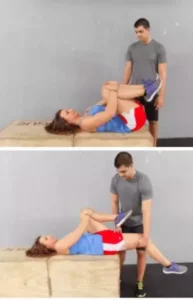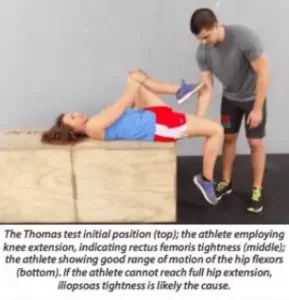Low back pain is a issue among people in general with almost 20% of people between ages 20 and 59 dealing with chronic low back pain. Getting more specific into injuries within the CrossFit population, low back injuries are the most common associated with powerlifting movements, and the second most common injury overall behind shoulders. Interestingly enough, low back pain occurs similarly in both active and inactive populations. There are a lot of reasons for that which we won’t get into much in this post, but it mostly centers around the cause of low back pain being much more complicated than a simple musculoskeletal cause. For the sake of keeping it simple today, I’m going to highlight 3 main causes of low back pain in athletes participating in CrossFit, and a few basic fixes.
***Disclaimer: You should NOT feel any sharp or unusual pain during these exercises. If your pain gets worse, immediately stop and either move on to a different exercise, or consult with a physical therapist, physician, or other qualified medical professional.
Tight Hip Flexors
Tight hip flexors can be a major cause of low back pain with CrossFit movements (Though it is very common that your hip flexors may not actually be “tight” at all. Don’t worry, that article is coming!). People get tight hip flexors for a few reasons. The most common reason to see hip flexors start to get tight is sitting for long periods of time throughout the day. Working in an office, long commutes, or the always-tempting Netflix binge can place you in a shortened position and lead to increased tension when you try to extend your hips. Below is a walkthrough of a test for tight hip flexors from Zach Long (thebarbellphysio.com) where he does a great job breaking it down simply for anyone to perform.

“To truly assess flexibility of the hip flexor musculature, the Thomas Test should be used. This quick test can be performed by any athlete, coach, or clinician.
The athlete begins sitting on the very edge of a box or treatment table.
Next, they lie back holding their knees towards their chest (but not pulled all the way to their chest).
The partner then holds and lowers on of the two legs down.
The partner should look for three things:
1. Does the thigh reach full extension (the thigh parallel to the ground).
2. Is the knee able to bend to 90 degrees of flexion without the thigh raising?If the knee does not make it to 90 degrees without the rising, tightness of the rectus femoris is to blame.
If the knee can flex to 90 degrees without the thigh rising but the thigh is unable to reach full extension, illiopsoas tightness is present.3. Does the thigh migrate laterally? If so, TFL tightness is present.
Without performance of muscle flexibility testing, it is irresponsible to diagnose (yourself or patient) with having tightened hip flexor musculature.”

As I mentioned, tight hip flexors can limit your hip extension range of motion which can potentially lead to low back pain. You can also develop some compensation for that lack of movement leading to risky movement patterns. There are a few ways to address tight hip
flexors with some videos for you below. As always, once you stretch and loosen up those muscles, make sure you try to load into that new range of motion to start developing a better movement pattern.
Note: static stretching is not ideal prior to a workout. Use this stretch post-workout or on rest days
Poor Core Control, Weakness
This is one of my favorite topics to discuss. The always mysterious “core”. What is it? How do you test for a “weak” core? Is core stability really what you need for low back pain? The short answer is, for low back pain, core strengthening is really no better than other more general exercises for pain reduction. That being said, being able to maintain a stable midline and control your body through higher intensity exercise is critical to prevent pain/injury. There aren’t a ton of good tests for core strength, though what I have found is one of the best ways to assess is to observe movement patterns. If you go overhead with your barbell like the wacky waving arm flailing inflatable tube man, you may have some core control issues. If you start to round your back really early on the deadlift and aren’t able to correct, besides needing to lower your weight, you probably need to think about addressing some midline issues. Below I’ve included some general exercises that can start to strength some of the common muscles used in trunk control.
Lifting with your back
I really wish this one wasn’t as common as it is. While during lifts you are supposed to use back musculature, it shouldn’t be ALL you use. Granted, some of the reasons you lift with your back could be the ones listed above, but in other cases it’s as simple as not being able to sequence your lifts properly, or drifting into poor movement patterns to try to move faster or lift more (don’t do that). Taking the time to break down a lift and ensure you are moving through it well and feeling things properly is huge. There are a ton of examples of exercises that need this type of input ranging from the squat and the deadlift all the way to overhead movements like the jerk and the press. We’ll likely get into those things in the future. For this post I’d like to focus on one of the more fundamental movements in CrossFit that quite often is done poorly and is significantly related to performance of higher level lifting movements – the kettlebell swing. Below you’ll see a video of both a poor example of kettlebell swing and a good one. The big key with these is to focus on driving the hips UP and not forward. This will change the line of drive and therefore adjust which muscles are the dominant driving force (hint: it should be your glutes).
n the video notice the hips are being driven up while maintaining a good midline position. He uses momentum from his hip drive to bring the kettlebell overhead vs using more shoulder and back to lift. A great way to check on your lifting form is to rely on your coaches, take videos of your lifts, and/or to consult with a medical provider that understands the movements you’re doing, and, going one step further, is capable of progressing you far enough along to actually return to lifting and CrossFit activities safely and in a way where you can make tangible progress. If you have questions about your back pain, lifting, or any other issues related to your health or fitness goals definitely reach out at dan@breakthroughperformanceavl.com or contact me for a free 15min phone consultation. Meucci RD, Fassa AG, Faria NMX. Prevalence of chronic low back pain: systematic review. Revista de Saúde Pública. 2015;49:1. doi:10.1590/S0034-8910.2015049005874. Weisenthal BM, Beck CA, Maloney MD, DeHaven KE, Giordano BD. Injury Rate and Patterns Among CrossFit Athletes. Orthopaedic Journal of Sports Medicine. 2014;2(4):2325967114531177. doi:10.1177/2325967114531177
Posted on 2018-04-05


